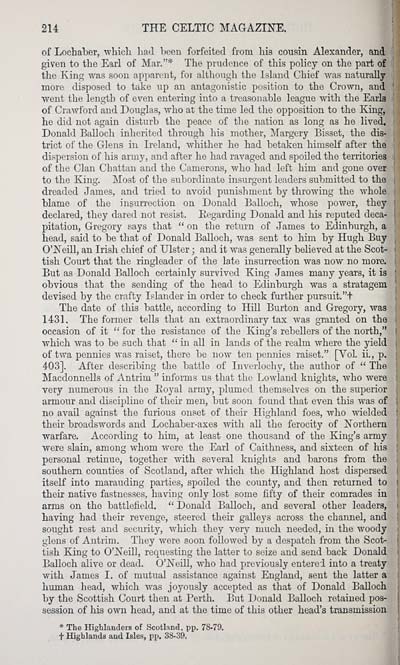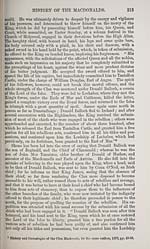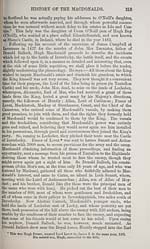Blair Collection > Celtic magazine > Volume 5
(224)
Download files
Complete book:
Individual page:
Thumbnail gallery: Grid view | List view

n.
214 THE CELTIC MAGAZINE.
of Lochaber, -whicli had heen forfeited from liis cousin Alexander, and
given to the Earl of Mar."* The prudence of this policy on the part of
the King was soon apparent, for although the Island Chief was naturally
more disposed to take up an antagonistic position to the Crown, and
went the length of even entering into a treasonable league with the Earia
of Crawford and Douglas, who at the time led the opposition to the King,
he did not again disturb the peace of the nation as long as he lived,
Donald Balloch inherited through his mother, Margery Bisset, the dis-
trict of the Glens in Ireland, whither he had betaken himself after the
dispersion of his army, and after he had ravaged and spoiled the territories
of the Clan Chattan and the Camerons, who had left him and gone over
to the King. Most of the subordinate insurgent leaders submitted to the
dreaded James, and tried to avoid punishment by throwing the whole
blame of the insurrection on Donald BaUoch, whose power, they
declared, they dared not resist. Regarding Donald and his reputed deca-
pitation, Gregory says that " on the return of James to Edinburgh, a
head, said to be that of Donald Balloch, was sent to him by Hugh Buy
O'JSTeiU, an Irish chief of Ulster ; and it was generally believed at the Scot-
tish Court that the ringleader of the late insurrection was now no more.
But as Donald Balloch certainly survived King James many years, it is
obvious that the sending of the head to Edinburgh was a stratagem
devised by the crafty Islander in order to check further pursuit. "t
The date of this battle, according to Hill Burton and Gregory, was
1431. The former tells that an extraordinary tax was granted on the
occasion of it " for the resistance of the King's rebeUers of the north,"
which was to be such that " in aU in lands of the realm where the yield
of twa pennies was raiset, there be now ten pennies raiset." [VoL ii, p.
403]. After describing the battle of Inverlochy, the author of " The
Macdonnells of Antrim " informs us that the Lowland knights, who were
very numerous in the Eoyal army, plumed themselves on the superior
armour and discipline of their men, but soon found that even this was of
no avail against the furious onset of their Highland foes, who wielded
their broadswords and Lochaber-axes with aU the ferocity of ISTorthern
warfare. According to him, at least one thousand of the King's army
were slain, among whom were the Earl of Caithness, and sixteen of his
personal retinue, together with several knights and barons from the
southern counties of Scotland, after which the Highland host dispersed
itself into marauding parties, spoiled the county, and then returned to
their native fastnesses, having only lost some fifty of theu" comrades in
arms on the battlefield. " Donald Balloch, and several other leaders,
having had their revenge, steered their galleys across the channel, and
sought rest and security, which they very much needed, in the woody
glens of Antrim. They were soon followed by a despatch from the Scot-
tish King to O'l^eiU, requesting the latter to seize and send back Donald
Balloch alive or dead. O'NeiU, who had previously entered into a treaty
with James I. of mutual assistance against England, sent the latter a
human head, which was joyously accepted as that of Donald Balloch
by the Scottish Court then at Perth. But 1 )onald Balloch retained pos-
session of his own head, and at the time of this other head's transmission
* The Highlanders of Scotland, pp. 78-79.
t Highlands and Isles, pp. 38-39.
214 THE CELTIC MAGAZINE.
of Lochaber, -whicli had heen forfeited from liis cousin Alexander, and
given to the Earl of Mar."* The prudence of this policy on the part of
the King was soon apparent, for although the Island Chief was naturally
more disposed to take up an antagonistic position to the Crown, and
went the length of even entering into a treasonable league with the Earia
of Crawford and Douglas, who at the time led the opposition to the King,
he did not again disturb the peace of the nation as long as he lived,
Donald Balloch inherited through his mother, Margery Bisset, the dis-
trict of the Glens in Ireland, whither he had betaken himself after the
dispersion of his army, and after he had ravaged and spoiled the territories
of the Clan Chattan and the Camerons, who had left him and gone over
to the King. Most of the subordinate insurgent leaders submitted to the
dreaded James, and tried to avoid punishment by throwing the whole
blame of the insurrection on Donald BaUoch, whose power, they
declared, they dared not resist. Regarding Donald and his reputed deca-
pitation, Gregory says that " on the return of James to Edinburgh, a
head, said to be that of Donald Balloch, was sent to him by Hugh Buy
O'JSTeiU, an Irish chief of Ulster ; and it was generally believed at the Scot-
tish Court that the ringleader of the late insurrection was now no more.
But as Donald Balloch certainly survived King James many years, it is
obvious that the sending of the head to Edinburgh was a stratagem
devised by the crafty Islander in order to check further pursuit. "t
The date of this battle, according to Hill Burton and Gregory, was
1431. The former tells that an extraordinary tax was granted on the
occasion of it " for the resistance of the King's rebeUers of the north,"
which was to be such that " in aU in lands of the realm where the yield
of twa pennies was raiset, there be now ten pennies raiset." [VoL ii, p.
403]. After describing the battle of Inverlochy, the author of " The
Macdonnells of Antrim " informs us that the Lowland knights, who were
very numerous in the Eoyal army, plumed themselves on the superior
armour and discipline of their men, but soon found that even this was of
no avail against the furious onset of their Highland foes, who wielded
their broadswords and Lochaber-axes with aU the ferocity of ISTorthern
warfare. According to him, at least one thousand of the King's army
were slain, among whom were the Earl of Caithness, and sixteen of his
personal retinue, together with several knights and barons from the
southern counties of Scotland, after which the Highland host dispersed
itself into marauding parties, spoiled the county, and then returned to
their native fastnesses, having only lost some fifty of theu" comrades in
arms on the battlefield. " Donald Balloch, and several other leaders,
having had their revenge, steered their galleys across the channel, and
sought rest and security, which they very much needed, in the woody
glens of Antrim. They were soon followed by a despatch from the Scot-
tish King to O'l^eiU, requesting the latter to seize and send back Donald
Balloch alive or dead. O'NeiU, who had previously entered into a treaty
with James I. of mutual assistance against England, sent the latter a
human head, which was joyously accepted as that of Donald Balloch
by the Scottish Court then at Perth. But 1 )onald Balloch retained pos-
session of his own head, and at the time of this other head's transmission
* The Highlanders of Scotland, pp. 78-79.
t Highlands and Isles, pp. 38-39.
Set display mode to: Large image | Transcription
Images and transcriptions on this page, including medium image downloads, may be used under the Creative Commons Attribution 4.0 International Licence unless otherwise stated. ![]()
| Early Gaelic Book Collections > Blair Collection > Celtic magazine > Volume 5 > (224) |
|---|
| Permanent URL | https://digital.nls.uk/76451516 |
|---|
| Description | Volume V, 1880. |
|---|---|
| Shelfmark | Blair.6 |
| Attribution and copyright: |
|
| Description | A selection of books from a collection of more than 500 titles, mostly on religious and literary topics. Also includes some material dealing with other Celtic languages and societies. Collection created towards the end of the 19th century by Lady Evelyn Stewart Murray. |
|---|
| Description | Selected items from five 'Special and Named Printed Collections'. Includes books in Gaelic and other Celtic languages, works about the Gaels, their languages, literature, culture and history. |
|---|

